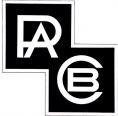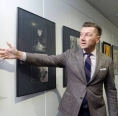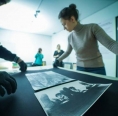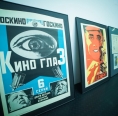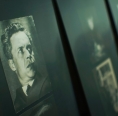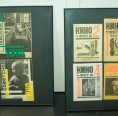-

Russian Avant-Garde: from Eisenstein to Rodchenko
-
Address:
-
Partners:
Names of leaders of the Soviet avant-garde are well-known. They include: news film pioneer and lyrist Dziga Vertov, master of cinema attractions and founder of the theory of cinematography of the ХХ century Sergey Eisenstein, film editing inventor and teacher Lev Kuleshov, actor and film artist Petr Galadzhev. It’s hard to imagine their creative work beyond the cultural and artistic context of the epoch, film magazines, avant-garde photo art, film posters of 1920-ies, traditions and innovation quests of scenography, studios, as well as schools of art.
Traditions of the film decoration art and theatre scenography were developed in Higher Art and Technical Studios in 1920-ies: film studios, movie theatres and cinema halls, film posters were designed in their faculties.
Poet Vladimir Mayakovsky can also be referred to outstanding cinema personalities of that period. Later he played roles in the films: Young Lady and Hooligan, Enchained with the Film, Born not for Money (scenarized based on Jack London’s Martin Eden). The atmosphere of formation of the national cinema industry fascinated him, too. Due to Mayakovsky one can speak of the impact of avant-garde on cinematograph, where the futuristic tradition of public scandal and epatage is aligned with the role playing in the movies. Later, Mayakovsky gave lectures on new art and poetry, recited his poems, was an idol of the students’ audience of the Higher Art and Technical Studios.
S. Eisenstein, L. Kuleshov and other film people became famous, first of all, due to their films, such as Cinema Eye and A Person with the Cinema Device, The Battleship Potemkin and October, Extraordinary Adventures of Mister West in the Country of the Bolsheviks and According to the Law. Other channel of revolutionary vision, of emergence of a new culture were magazine publications, experimental photo works of Alexander Rodchenko. Aesthetics of cinema avant-garde cannot be separated from aesthetics of graphic design and photograph, and even that of architecture. Representatives of all art genres were aiming to what we today call the media art.
For example, bold film posters by the brothers Stenbergs and Petr Galaadgaev, being a part of avant-garde advertisement, visually “dubbed” silent movies in close cooperation with the revolutionary new form of the photograph – due to the revolution made by Alexander Rodchenko, Boris Ignatovich and Eleasar Langman.
Film magazines existed as another mass media genre of 1920-ies that could be met at the news stalls. They combines both articles of theory of cinema art and experimental photograph and graphics. Here, “left” artists that came into the photograph, their successors, professional photographers and journalists created a new “photo perception” of the world.
The entire variety of media activities of pioneers of the cinema avant-garde, photography and graphic design was aimed to bring up a new world vision. Cinema turned out to be the heart of many creative projects. This is how the Russian avant-garde extended territory of art. Here, masters of avant-garde were assisted by the entire generation of graduates of the Higher Art and Technical Studios that asserted new ways of development of the Russian artistic culture.
The exhibition is presented by Archive of A. Rodchenko and V. Stepanoa and Stroganov Moscow State University of Arts and Industry. Stroganov Emperor’s School was founded in 1825, and after the revolution was transformed into the Higher Art and Technical Studio, a world known school of modern art and design, where the best representatives of the Russian avant-garde: V. Kandinsky, K. Malevich, V. Tatlin, A. Rodchenko, V. Stepanova, O. Rozanova, L. Popova and many others.
The Russian Avant-Garde exhibition will take place in Magnezit Museum (Satka, Solnechnaya str. 34). Working hours: Monday through Friday, 9:00 a.m. until 5.00 p.m., lunch break 12:00 p.m. – 1:00 p.m., Saturday, Sunday since 10.00 a.m. until 4.00 p.m.
-
26.08 - 26.08
DIARY OF THE THIRD INDUSTRIAL BIENNALE
-
28.11 - 28.11
MY SATKA FESTIVAL WINS THE CONTEST OF CORPORATE VOLUNTEER PROJECTS
-
13.10 - 15.10
COOPERATION WITH VGIBL NAMED AFTER M.I. RUDOMINO

